*This post was previously live on my other site TheWingedFork.com
A home to Eastern religions, Asia is the land of temples! But it’s also home to some of the most stunning and beautiful churches in the world; some even more awe-inspiring that the churches in Europe. If you’re traveling through Asia, you obviously have these questions. Which are the top famous churches in Asia that you absolutely must visit? Which are the most popular churches in Asia? How old are the churches in Asia? Which beautiful Asian churches should I visit? Well, here they are! The list of must-visit churches in Asia in random order.
1. Memorial Church of Moses church on Mount Nebo, Jordan
By Lindsay of CarpeDiemOurWay
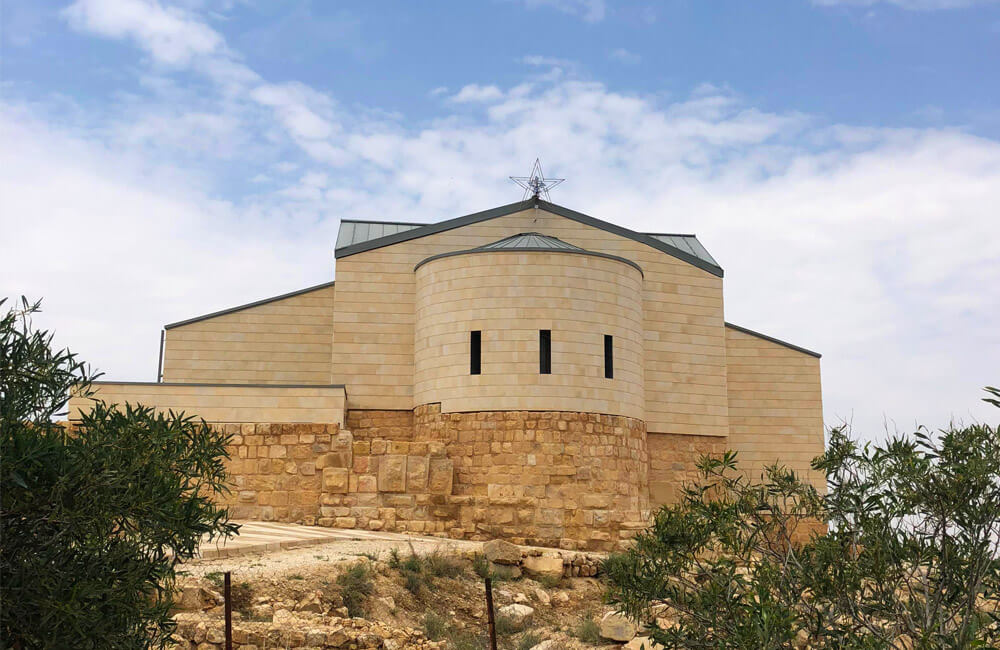
Mount Nebo is known as one of the top biblical sites in the world and is home to the Memorial Church of Moses. This site, in the mountains of Jordan, 40 kilometres south of the capital city of Amman, contains a church, built as a memorial to Moses as it is believed that he stood on this spot with the Israelites and pointed to the promised land.
The location provides a panorama of the Holy Land and Christian tradition says that Moses was buried here although the place of his burial was never specified in the Bible.
Today you will find a serpentine cross sculpture depicting Moses’ stick, a monument of the Bible commemorating Pope John Paul II’s visit in the year 2000, and perhaps the most impressive feature of all, the brand new Memorial Church of Moses, built atop the 1500 year old church remains.
Inside the church you will find mosaics from the 5th century on the floors. This biblical site is owned by Franciscan Monks who in 1933 started excavations on the mountain. With the help of locals, they unearthed the remains of the preexisting church site and the mosaic tiles. Depicted on the tiles are images of daily life, animals and hunting, olive trees and grape leaves as well as the tree of life.
You can read this post Is Jordan Safe? if you are curious about visiting want to know about safety in Jordan.
2. Holy Rosary Parish Church, in Angeles City (Philippines)
By Ruben from Gamin Traveler

The Holy Rosary Parish Church is one of the most visited historical landmarks in the Philippines. The history of the church started with the history of Angeles City. The Holy Rosary Parish Church was constructed from 1877 to 1896 by the “Polo y Servicio”, the constrained and unpaid work of the Filipino local individuals to all men by the Spanish frontier government. It also served as hospital and sanctuary for the U.S. Army. Another part of the church was turned into the execution grounds from 1896-1898 in shooting down Filipino revolutionaries and suspects by the Spanish powers. The government restored the church in early 1940s with the help of American troops after it was hit by an American bombler plane during the World War II. In 1849, it became a parish together with town of Culiat becoming Angeles City.
Today, the Holy Rosary Parish Church stands in Angeles, Pampanga where local devotees and tourists flock to attend church. They also organize feasts in honor of not just Santo Rosario but also Our Lady of Rosary de Naval, which is a local celebration in the Philippines. It’s a must to visit and take in a touch of Philippine history from!
3. Tan Dinh Church, the pastel-pink gothic church in Ho Chi Minh City
By Maire from Temples and Treehouses
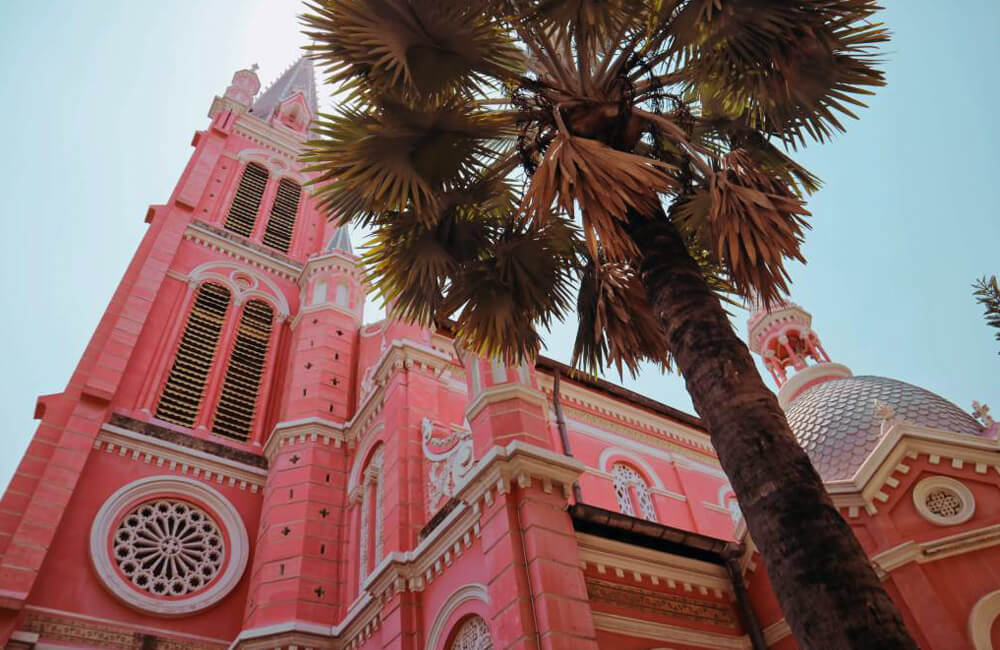
Tan Dinh Church is a pink Disney castle-style gothic church, plonked on a busy street in Ho Chi Minh City, Vietnam. This dreamy wedding cake of a building is a working Catholic Church and one of the most important in the city. It was built in French colonial times and is painted an Instagram-friendly peony pink and white.
Weirdly, when I visited the impressive Tan Dinh Church there were hardly any tourists around. It isn’t as well known as Ho Chi Minh City’s Central Post Office or Notre Dame Cathedral (two other famous landmarks from the same time period). I have no idea why though — it’s an utterly gorgeous building and to be honest, despite not being the most famous it was my favourite sight in the whole of Ho Chi Minh City!
Tan Dinh Church is located pretty centrally in District 3. You can actually walk there from various other central landmarks — but Ho Chi Minh City tends to be hot and humid with crazy traffic, plus taxis are cheap, so I’d recommend simply hopping into a cab and asking them to take you to the Barbie Church!
4. Vank Cathedral, Isfahan, Iran
By Nicholas from Rambling Feet
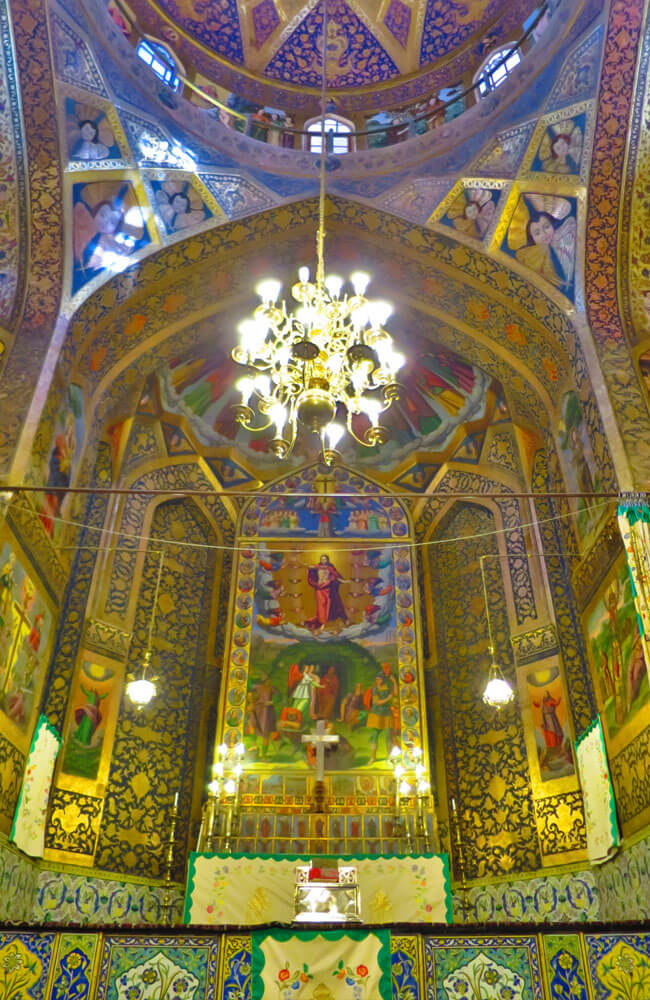
When the Armenian community from Julfa (in present-day Azerbaijan) was displaced by Shah Abbas I in the 17th Century, the Safavid ruler established an Armenian quarter called New Julfah in Isfahan, Iran. The community settled there and the Holy Saviour Cathedral, also known as Vank Cathedral, was one of the first churches that it built.
Within the cathedral compound, there is also a small museum (included in the entrance fee) featuring religious and historical artefacts, including the first book that was printed in Iran. It also prominently documents the Armenian genocide that the Ottoman Empire (the precursor of modern-day Turkey) waged in its final years.
As for the cathedral, its plain dome and exterior belie the richness of the art within. Gilded frescoes depicting the Old and New Testaments and saints cram the walls of this ornate cathedral. Look a little closer and you’ll find Persian floral motifs in the borders. The altar is ornamented with tiles that would not look out of place in any of Iran’s grandest mosques. The combination of Persian and Armenian Christian architecture is unique to this part of the world. If you have never been exposed to Eastern Churches, you could do worse than make Vank Cathedral a priority when you visit Iran.
5. Myeongdong Cathedral, Seoul, South Korea
By Marie from Be Marie Korea
Myeong-dong Cathedral is located in the middle of the touristic center of Seoul. The Gothic Cathedral, built in 1892, is the main church for the Archdiocese of Seoul and it was the birthplace of the Roman Catholic Community in South Korea. The Cathedral was constructed under the rule of Emperor Gojong but was funded by the Paris Foreign Missions Society and costed $60,000 USD.
Christianity was only introduced to Korea in the 17th century and the Christians had a very difficult time until the Joseon Dynasty as Buddhism was Korea’s main religion at that time. Many Catholics and foreign missionaries were killed. Now 25% of the country is Christian, compared to 15% being Buddhist.
Now the magnificent church is surrounded by department stores, street food vendors and themed coffee shops in Seoul’s most popular shopping district.
6. Saint Nicholas Church – Demre, Turkey
By Pascale from Slow Travel Guide
The Saint Nicholas church in Demre may not be the most exciting building when seen from the outside, it does hide a fascinating interior and has an even more intriguing history. The Byzantine church is worth visiting, also if the story of Saint Nicholas, who later became Santa Claus or Sinterklaas, has no spiritual significance to you. Saint Nicholas from Patara was the Bishop of Myra during the 4th-century who lived and worked here. Legend has it Saint Nicholas was involved in helping young people and the poor. The original church was destroyed in an earthquake, only to be repaired and damaged by the Arab invasions.
The current church dates back to the 11th-century, with today’s ruins being the result of restorations and extensions carried out in different periods. Inside, you’ll see spectacular mosaics, domes, frescoes, and tombs. Recently, a team of specialists discovered a hidden temple underneath the church. Speculations have risen that this temple may very well contain the tomb of Saint Nicholas. Researchers at work there claim they will find Saint Nicholas undamaged in the temple. If you want to visit the church, try visiting early morning or late afternoon. In avoiding the crowds, you get a far more immersive experience.
7. Basilica of Bom Jesus and the Churches and Convents of Goa
By Natalia from My Trip Hack
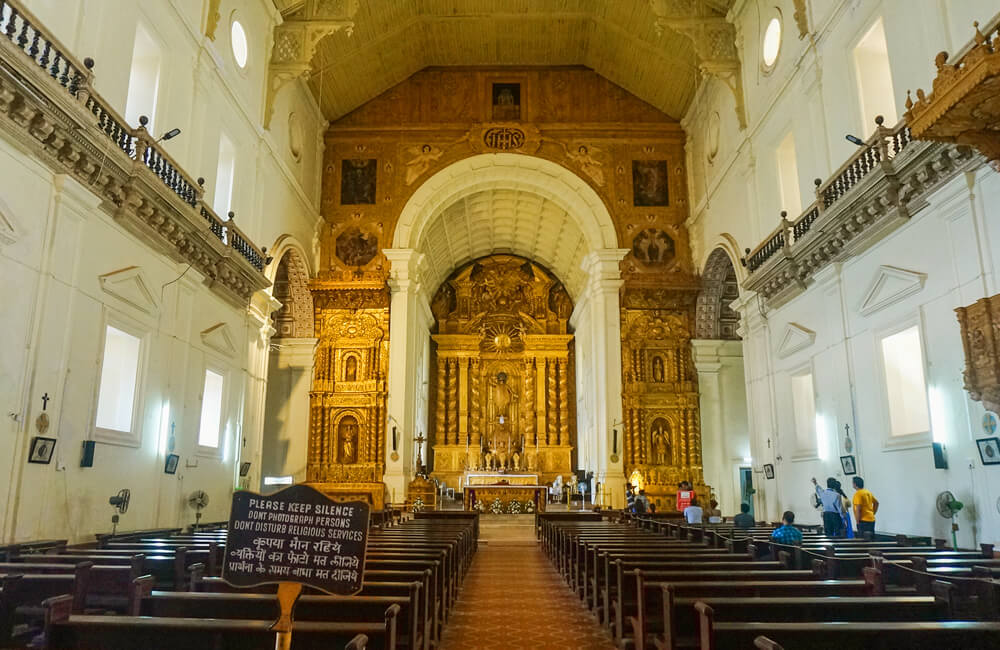
Goa is mainly known for its beaches and nightlife, though there are also several heritage sites in the state. One of them is Old Goa or Goa Velha. It used to be a capital of Portuguese India. Nowadays it’s famous for its monuments and churches.
Despite each of the churches in Old Goa is interesting in its own way, one of the most visited sites is Basilica of Bom Jesus. It was built back in 1605, thus you can see the elements of late-Renaissance in its structure. It took almost 11 years to complete the constructions of basilica.
This Church became famous in the Catholic world as it has the tomb of St.Francis Xavier. St.Francis is renowned for his missionary voyages in the East. Despite the intricate exteriors are impacted by monsoons every year, Bom Jesus is the only church in Old Goa not plastered on the outside.
In the 1950s one of the Portuguese conservationists removed the plaster stating the stone will strengthen itself with years. Since then, no one has installed the plaster back despite numerous other restorations in different parts of the complex. Churches and Convents of Goa became UNESCO heritage site in 1986.
8. Church Of St. Augustine In Velha, Old Goa, India
By Aaron from Abby’s Hearth
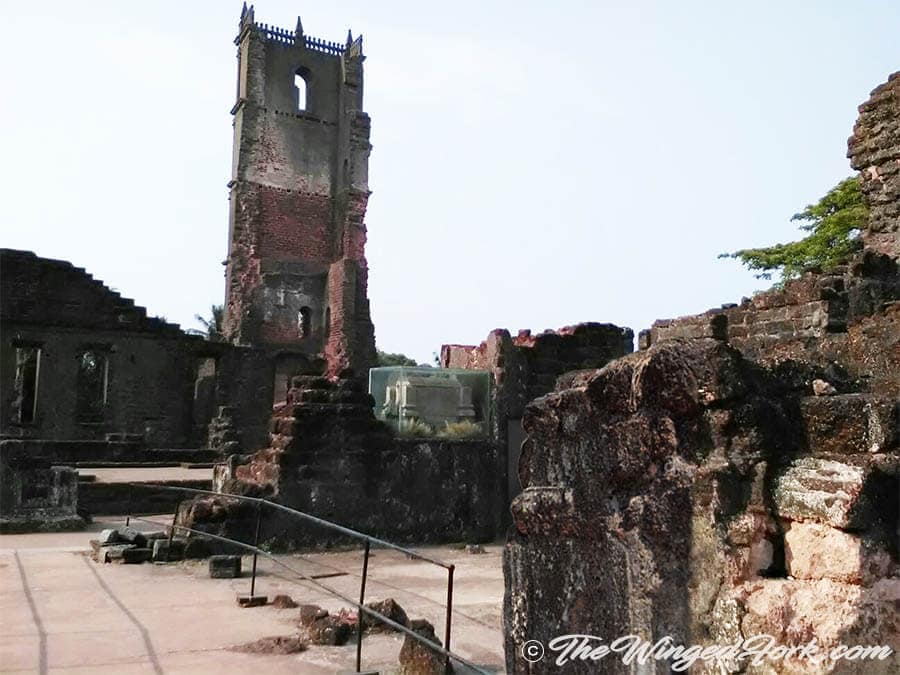
In the Velha region of Old Goa on Holy Hill (Monte Santo) and just off the banks of the river Mandovi sit the ruins of the tower of St. Augustine’s monastery and those of the once enormous church of Nossa Senhora de Graca (Our Lady of Grace).
Augustinian friars begun construction of this once stupendous structure after their arrival in 1587. Construction of the monastery and the church was completed between 1597 and 1602.
This gave the Nossa Senhora de Graca the reputation of being one of the 3 greatest Augustinian churches of the Iberian world, the other 2 being the Basilica of Escoral in Spain and St. Vincente de Fora in Lisbon.
The tower that remains was one of the four original towers and has a number of myths associated with it. Find out more about these awe-inspiring ruins in my bit about unusual Goa here.
9. Saint Nicholas chapel, Protaras, Cyprus
By Dani from A Baby Abroad

Agios Nikolaos Church, or Church of Saint Nicholas, is a small chapel in the Protaras area of Cyprus. It is located right on Kalamies Beach, next to a fishing harbor.
There is a legend that tells about Agio Nikolaos resurrecting a drowned sailor who was traveling to Jerusalem. Like this, many of his miracles are related to the sea, the reason for which he is the patron saint of sailors. This is also why his tiny church was built next to the fishing harbor in Protaras, where locals still believe he is protecting their boats and crew.
Unlike western churches, that are designed with high spires that focus the worshippers aim towards heaven and god, this Orthodox church represents bringing god to earth. It has a blue dome and whitewashed walls, that resemble traditional greek colors.
This church is also a popular destination for weddings and christenings. It is, in fact, a very romantic place as it is located practically over the water. Sunsets and sunrises here are beautiful, although any time of day makes for a picture-perfect scenery.
If you want to see a unique church that is off the beaten path, then Agios Nikolaos is one you cannot miss.
10. Ruins of St. Paul’s, Macau, PRC
By Emily from Wander-Lush
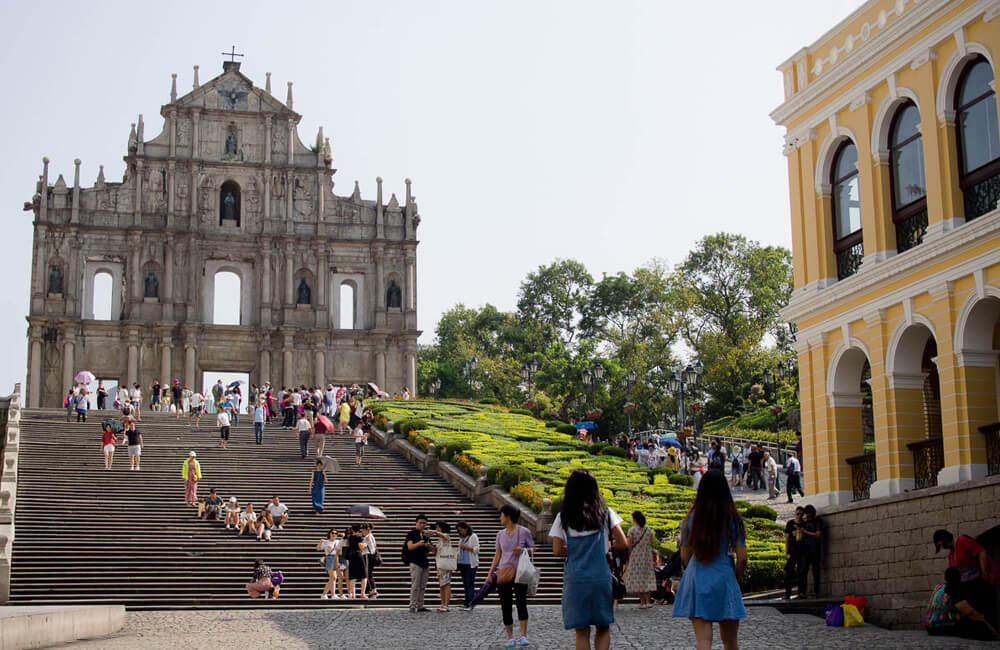
An autonomous enclave on China’s southern coast famous for its casinos and nightlife might be the last place you’d expect to find one of the world’s great churches. But the Ruins of St. Paul’s is emblematic of modern-day Macau and its Portuguese heritage.
When it was completed in 1640, the Church of St. Paul was one of the largest Catholic churches in Asia. The adjoining St. Paul’s College, a Jesuit training center, was the first Western university in the region. The complex was a project of the Portuguese, who colonized Macau in the mid-16 th century and remained there right up until 1999. After serving as a house of worship for almost 200 years, the church was gutted by a fire in 1835 and left to weather away.
All that remains of St. Paul’s is a single façade. The looming silhouette retains its original stonework and sculptural elements. Interestingly, it was Japanese Christians in exile who were responsible for the carvings, which blend Jesuit and Eastern imagery. It’s also possible to visit the church’s crypt, which houses a small collection of relics and religious artworks.
Today, the Ruins of St. Paul’s doesn’t really attract the pious—but rather zealous Instagrammers who jostle for photos on the vast stone steps.
11. Santa Cruz Cathedral Basilica in Kochi, India
By Johann from Escaping Life
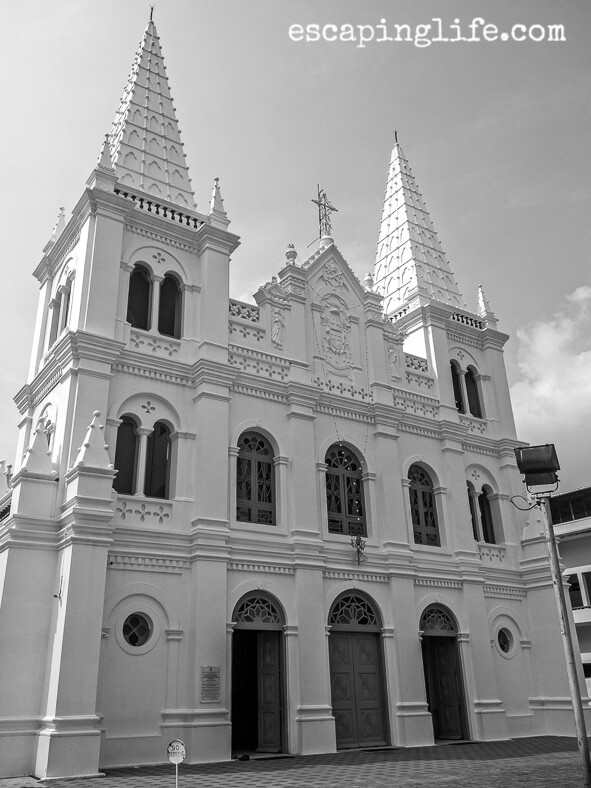
One of the first churches to be established in India by the Portuguese. The Santa Cruz Cathedral Basilica still stands tall to tell a tale or two of the multiple European powers who conquered the fort city of Santa Cruz. Yes, Fort Cochin, the small town in Kerala was once called Santa Cruz, after which the church got named. In its 513-year-old existence, the church has seen the Portuguese, the Dutch and the British who ruled the fort town successively.
Built in 1505, after the then Kochi Maharaja donated the piece of land now called Fort Cochin to build a Portuguese Fort. In 1558, the church was raised to the status of a cathedral. When the Dutch overthrew the Portuguese in 1663, they razed all the Catholic churches to the ground leaving behind the Santa Cruz Cathedral and the St. Francis Church. The Dutch converted the church to store their arms and ammunition. With the arrival of the British, the church was brought down.
The church was rebuilt at a new space and was consecrated in 1905 under the British rule. The church was raised to the status of a Basilica by Pope John Paul II in 1984. Inspired by Indo-European gothic design, the church now stands with whitewashed walls and tall spires and large paintings and frescoes by an Italian artist by the name of Fra Antonia Moscheni depicting the Passion of the Christ.
Don’t miss this historical church while on a visit to the city of Kochi.
12. Church of Our Lady of the Immaculate Conception, Panjim, Goa, India
By Ellie & Ravi from Soul Travel Blog

In the heart of Panjim, Goa, lies one of India’s most spectacular churches. Built in 1541, it’s one of Panjim’s most recognised landmarks, with its bright white and blue and elaborate staircases leading up to the entrance. It’s built in the classic Portuguese Baroque style, and played a part in the Portuguese religious expansion in Goa, during the days of Portuguese conquest along coastal India, especially Goa.
The church is home to an ancient bell – thought to be the largest of its kind in India – which was recovered form the Augustinian ruins of another church in Old Goa: Our Church of the Lady of Grace.
The church is open to the public, and overlooks the city’s municipal garden. For extra wow factor, you can visit during early December, when the church is lit up as part of the Festival of Our Lady of the Immaculate Conception which is celebrated on the 8th December each year. Read this post for more about exploring Goa.
13. The Church of St. Mary the Virgin in Sagada, Philippines
By Adriana from Czech the World
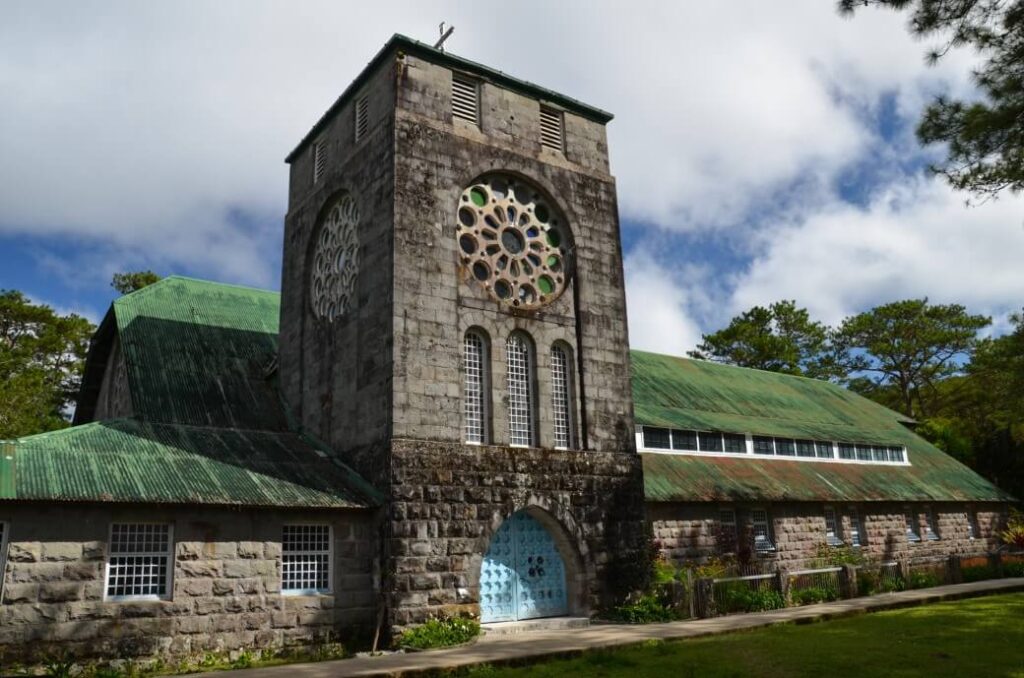
Sagada is a small town in the Mountain Province of the Philippines, Sagada lies on the biggest island of the Philippines – Luzon and is located about 400 km north from Manila. There are several tourist spots in Sagada and the Episcopal Church o St. Mary the Virgin is one of them. It’s quite impressive to see such a big church in a small town. The church was built in 1904 by Americal missionaries led by Rev. John Staunton with the help of local residents, after the big storms that hit and devastated the town. The Reverend’s name and date of birth and passing carved on a marble slab can be found on the post of the gate, only a few steps before the church.
The church has a very spacious interior designed in minimalistic style. There is a daily mass at 6 AM. The most interesting thing is the aerial cemetery and hanging coffins – the entrance to that place „the Echo Valley“ is just a few dozens of meters behind the church. You can get there only with local guides and it is very interesting to hear about the Sagada’s burial rituals.
14. Armenian Church in Chennai, India
By Bhushavali from My Travelogue by Bhushavali
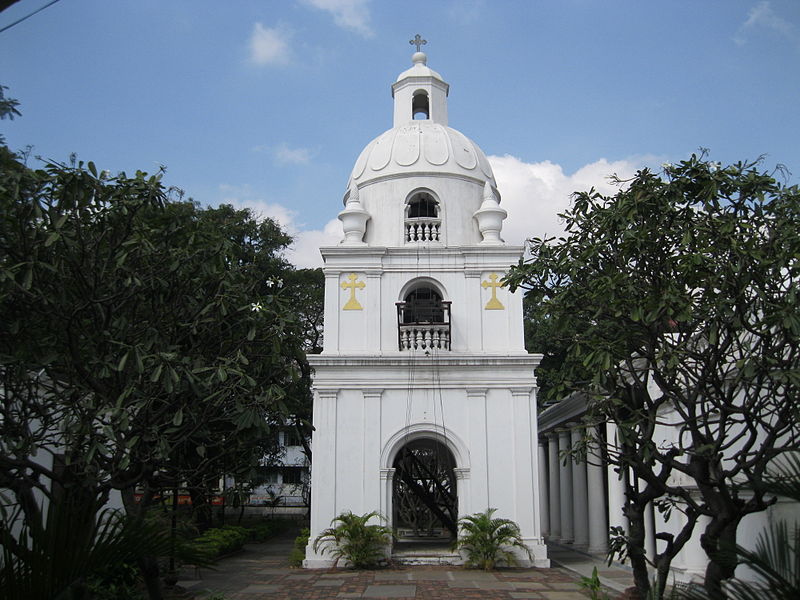
Pic by Paliakara from Wiki CC by SA 3.0
Armenians originally belong to the Armenia (obviously!), present day Turkey, Iran region. Christianity has been a strong hold here since ages and it was one of the earliest country to declare Christianity as the state religion in 301 CE. Over time, the people from there dispersed all over the world and Chennai, India was also one of the places where they settled! When a community of Armenians settled here, obviously they built their own place of worship – the Armenian Church of Chennai, built in 1712!
Completely surrounded by greenery, the church doesn’t even feel like its bang in the centre of a very busy commercial area in Chennai! It has the graves of around 350 Armenians who had made Chennai their home centuries ago! Most of them were rich merchants. The tombstones that depict ruler & scissor would have been textile merchants, the ones that depict stones & balance would have been gem stone merchants & the ones the depict wine glasses & grapes would have been wine merchants etc.
The interiors are elegant and the original wooden structure has been maintained. The original altar image is gone though! The most fascinating feature of the church is its Belfry, in a separate, beautiful, domed building. There are 6 bells cast between 1719 to 1737. Today these bells are rung only once a week.
15. Parish of Nuestra Senora de La Paz, La Paz, Abra, Philippines
By Dave of Silverbackpacker
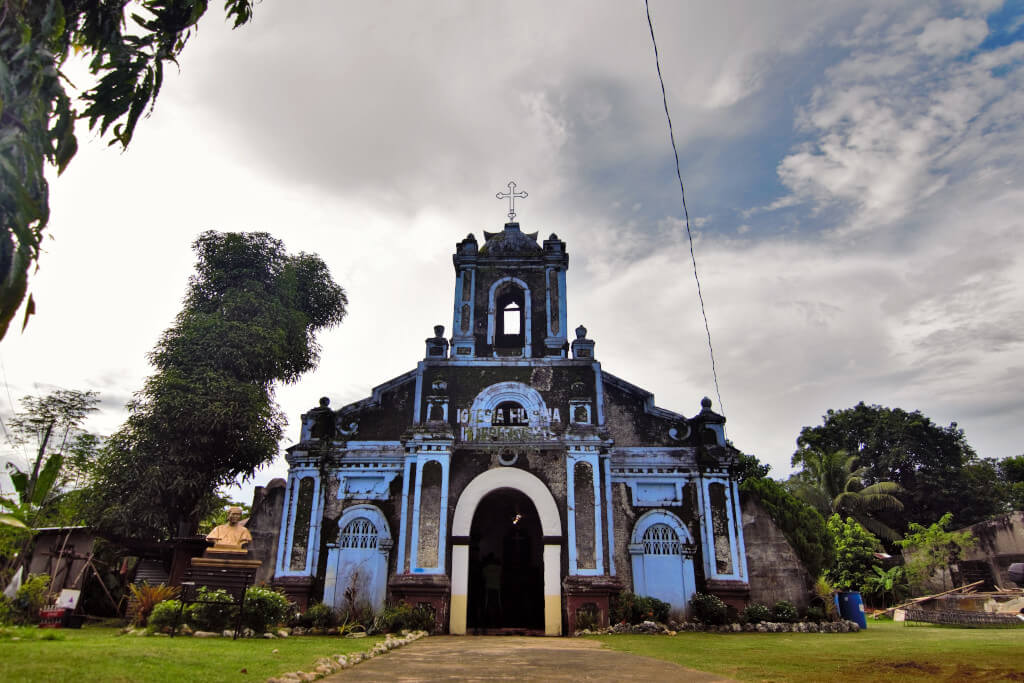
The Aglipayan Church, also known as “Iglesia Filipina Independente or IFI” in the Philippines, broke away from the Catholic Church in 1902, four years after the revolution which ended Spanish rule of the country.
One of the first Iglesia Filipina Independente Churches was Nuestra Senora de La Paz (Our Lady of Peace) in the town of La Paz. Situated in Poblacion, the church is considered as one of the most beautiful Aglipayan churches in the country.
The Parish became one of the founding members of the newly founded Iglesia Filipina Independiente during the incumbency of Father Benigno de Lara in 1902. Built in the 1880’s from locally made red clay bricks, like most of the Spanish era churches in Abra, with a Bell Tower at the front, the church more resembles an English village church building than a Spanish structure.
There were once three bells but over time two of them have become cracked and damaged. Only one bell now remains. Above the entrance the text “Iglesia Catolica Apostolica Filipina” is carved into the stone.
The oldest record in the church is a Baptismal one from 1889. Nuestra Senora de La Paz Church is now a listed heritage building.
16. Our Lady of Angels Church, Pondicherry, Tamil Nadu, India
By Rose of Where Goes Rose

The sunny, pastel-painted city of Pondicherry is a popular spot for foreign and local tourists travelling South India. When it comes to India’s colonial history, most people will think of British rule. However, the city of Pondicherry in Tamil Nadu was ruled by the French which explains the French street names and abundant churches. To this day, many Pondicherry locals still speak French as well as Tamil, and many of the Pondy restaurants serve French cuisine.
One of the most prominent features of Pondicherry is Our Lady of Angels Church located on Dumas Street. Not only is this one of the oldest churches in Pondicherry, built in 1855 by architect Louis Guerre, but it’s the only one in the area to host mass in three languages, French, Tamil and English.
Built in Greco Roman style, the twin towers of this pretty pink church can be seen from all over Pondicherry. A fun fact about this church is that egg was one of the ingredients (alongside pink paint and limestone) used to paint the outside!
Our Lady of Angels Church can be found in the heart of Pondicherry’s leafy White Town surrounded by cute cafes and green parks. For more details, check out Where Goes Rose’s Pondicherry Travel Guide.
17. Daraga Church in Legazpi City, Philippines
By Roshni from The Wanderlust Within
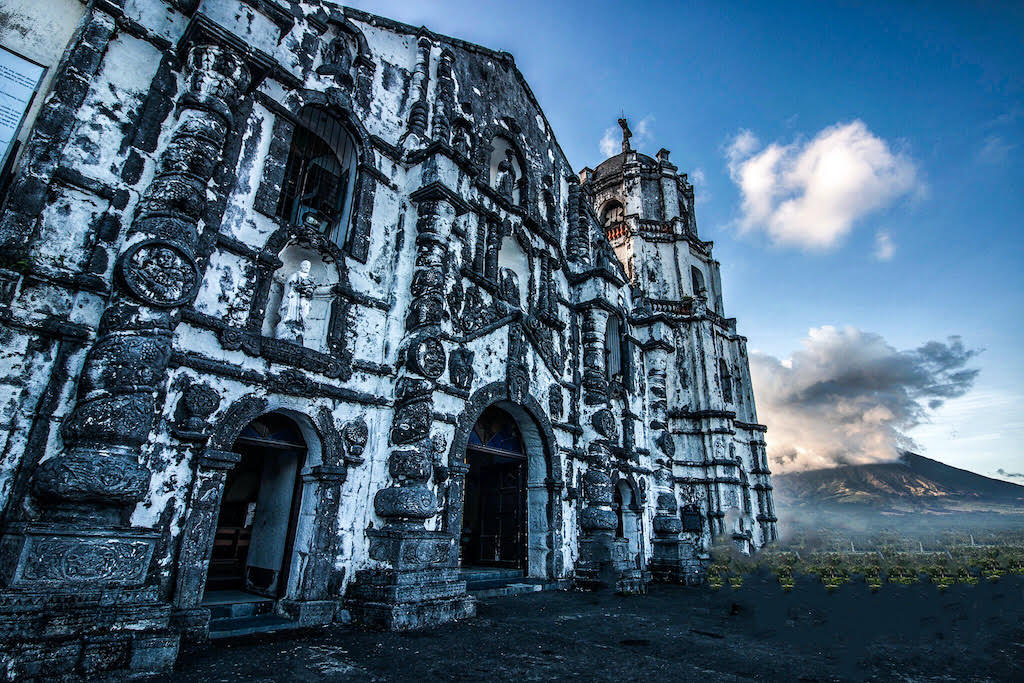
Daraga Church is an iconic white structure that looms over Legazpi City in the Philippines. It is one of the most popular tourist spots in Albay, and is also known as the Nuestra Señora de la Porteria Parish Church. Daraga Church is Roman Catholic and was built in 1773 by Franciscan missionaries, and is located next to the most active volcano in the Philippines, Mount Mayon. The unique white facade of Daraga Church is made of volcanic rocks from Mayon’s greatest eruption in 1814.
The architecture of the church is baroque, but many say its a mix of Mexican baroque and Renaissance gothic. The exterior has four columns, each with medallions at its core, decorated with images of the Evangelists. The white volcanic rock facade also features images of Franciscan saints, the coat of arms of the Franciscan Order, and images of the twelve apostles.
In 2007, Daraga Church was declared a National Cultural Treasure, and today visitors flock to the site to take in its unique beauty and unobstructed views of Mayon Volcano beside it.
18. Dali Trinity Church in Yunnan, China
By De Wet & Jin from Museum of Wander
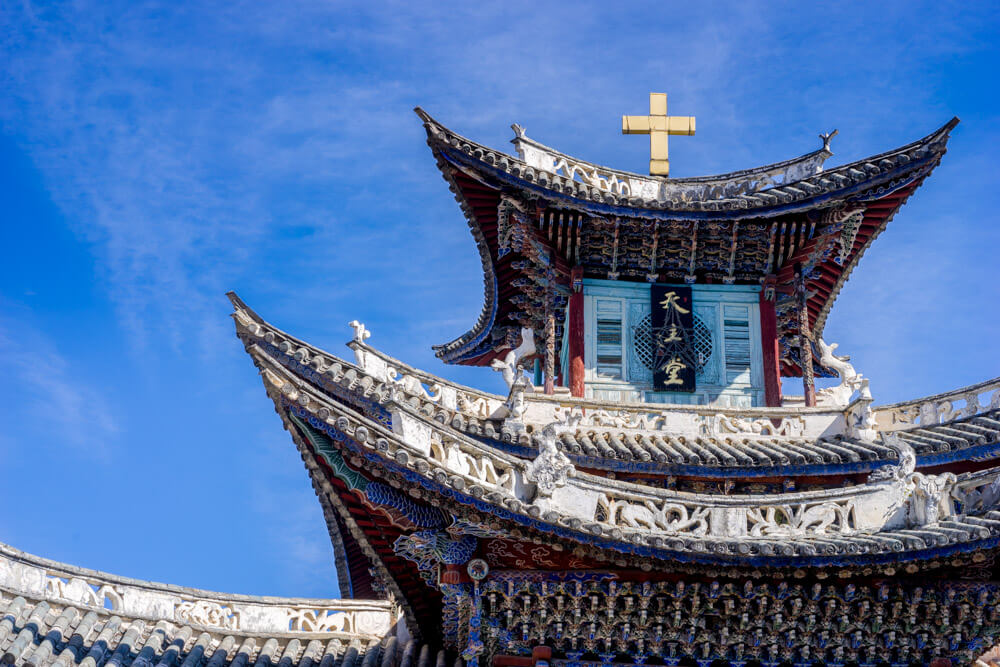
The Dali Trinity Catholic Church in China’s Yunnan province is a flying dragon that swallowed a church. Ignore the cross on the roof and you’ll think it’s a Chinese temple. It surely is one of the most unique churches you’ll ever visit.
French and Swiss missionaries built this church in 1927 and the result is a combination of extravagant local Bai architecture on the outside and a plain but colorful interior. The church is completely constructed from wood.
Look carefully at the decorations on the exterior. Here you’ll find folklore depictions of the Bai minority group mixed with scenes from the bible and traditional Chinese legends. It is recognized by the Chinese government as a heritage monument for its integration of minority styles.
The beautiful old town of Dali on the shore of Lake Erhai has been a popular stop for travelers in Yunnan province for decades. The catholic church is located inside the city wall of old town Dali. Signs saying “Catholic Church” around the old town will point you in the right direction. The church sits at the back of a traditional Chinese courtyard which you enter through a small entryway. It’s easy to miss, so look out for the cross on the gate of the entryway, or the Chinese characters 天主堂.
19. Church of the Holy Sepulchre in Jerusalem, Israel

The Church of the Holy Sepulchre in the ancient city of Jerusalem is one of the most famous sites in Jerusalem Old Town. In a city that is filled with holy places, for Christians, the Church of the Holy Sepulchre is the most sacred one since it is believed to be the site of the crucifixion, burial, and resurrection of Jesus Christ.
The original Church of the Holy Sepulchre was built under the instructions of the Roman Emperor Constantine I, who had converted to Christianity and decided to build a church over the temple of Venus in Jerusalem. During the demolition process, a tomb was found, and it was believed this was the tomb of Jesus.
According to the legend, a few years later, Constantine’s mother discovered the relic of the True Cross. Throughout the years, the True Cross was stolen and then returned, the church was converted into a mosque and then damaged by a fire, and in 1009 it was destroyed under the orders of Fatimid caliph Al-Hakim bi-Amr Allah. A new church was completed in 1048. Ever since then, the church has been a significant pilgrimage site for Christians.
The church is located in a small compound in the Christian Quarter of Jerusalem, and it is shared by several Christian communities: Roman Catholic, Greek Orthodox, Coptic, Syrian Orthodox and Armenian.
Looking at the Church of the Holy Sepulchre from outside, it seems very modest in size and appearance. However, once you step inside, you can immediately sense the holiness of the place and its deep religious significance. Inside the church, the first thing you will see in front of you is the Stone of Anointing, where Christ’s body was prepared for burial. You will probably see believers rubbing something against the stone to absorb its sacredness. The steps to the right will lead you to the richly decorated Calvary, where Jesus was crucified. But the most sacred part where the Holy Sepulchre (Christ’s tomb) can be found is located under the massive dome. The church is always filled with tourists and believers alike, so if you want to avoid the crowd, try getting there early in the morning or in late the afternoon.
We’ve been to many churches during our travels, but we’ve found the atmosphere inside this church to be extremely special. Watching the faces of the visitors, you can tell this is a life-changing experience for some of them, and that’s what makes it a must-see attraction for any tourist visiting Israel, regardless of his religion.
20. Gergeti Trinity Church, Georgia
By Emily from Wander-Lush
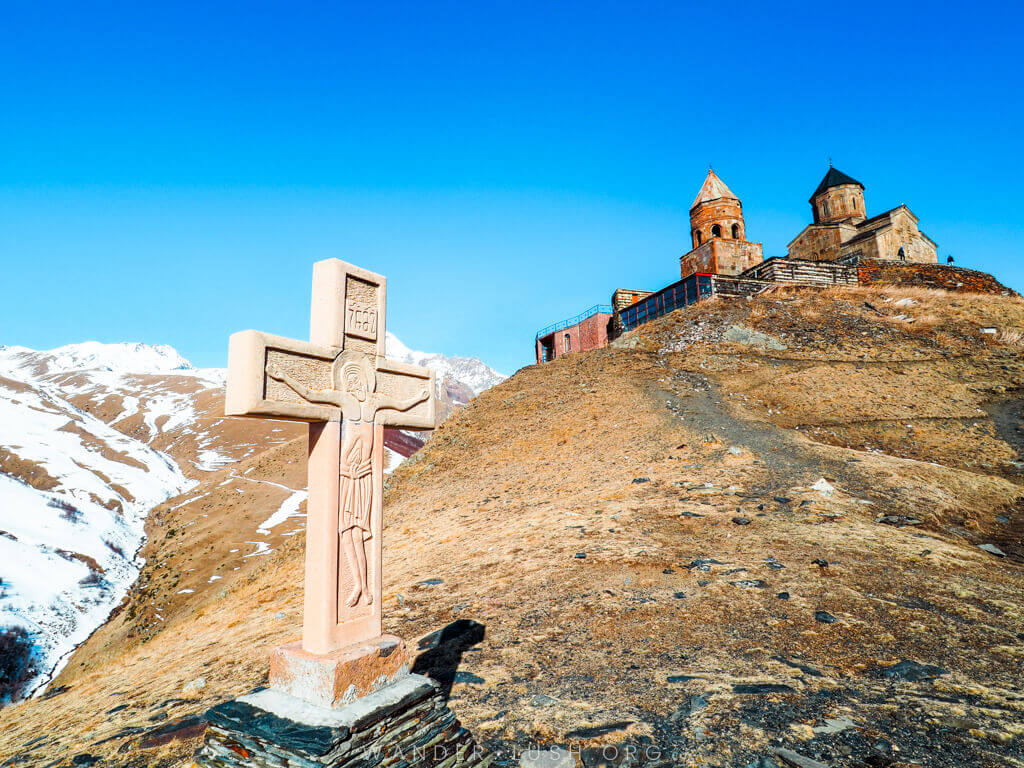
Gergeti Trinity Church, officially Holy Trinity Church, has become the poster child for tourism in Georgia and a symbol for the entire Caucasus region. It’s not hard to see why – the church’s setting amidst the imposing Greater Caucasus mountains is nothing short of breathtaking.
Gergeti sits at an elevation of 2,170 metres and can be reached by car or an easy three-hour-return hike from the nearby town of Kazbegi. Built in the 14th century, the complex consists of a stone Orthodox church and a bell tower enclosed by a wall. So secluded is the location, when Georgia’s old capital, Mtskheta, was being raided, precious relics were transferred to Gergeti Trinity for safekeeping (including Saint Nino’s Cross, which belonged to the woman responsible for brining Christianity to Georgia in the year 319). After a period of dormancy when Georgia fell under Soviet rule, the church is one again active, hosting regular mass.
In contrast to the dramatic location, the church itself is quite humble when viewed up close. Inside, it’s small and dimly lit as Orthodox churches often are. Clusters of votive candles illuminate ornate icons hung from the rough walls. From the church yard outside, you get incredible views of the mountains and valley below.
21. St.Mary’s Cathedral in Batticaloa, Sri Lanka
By Josh and Sarah from Veggie Vagabonds
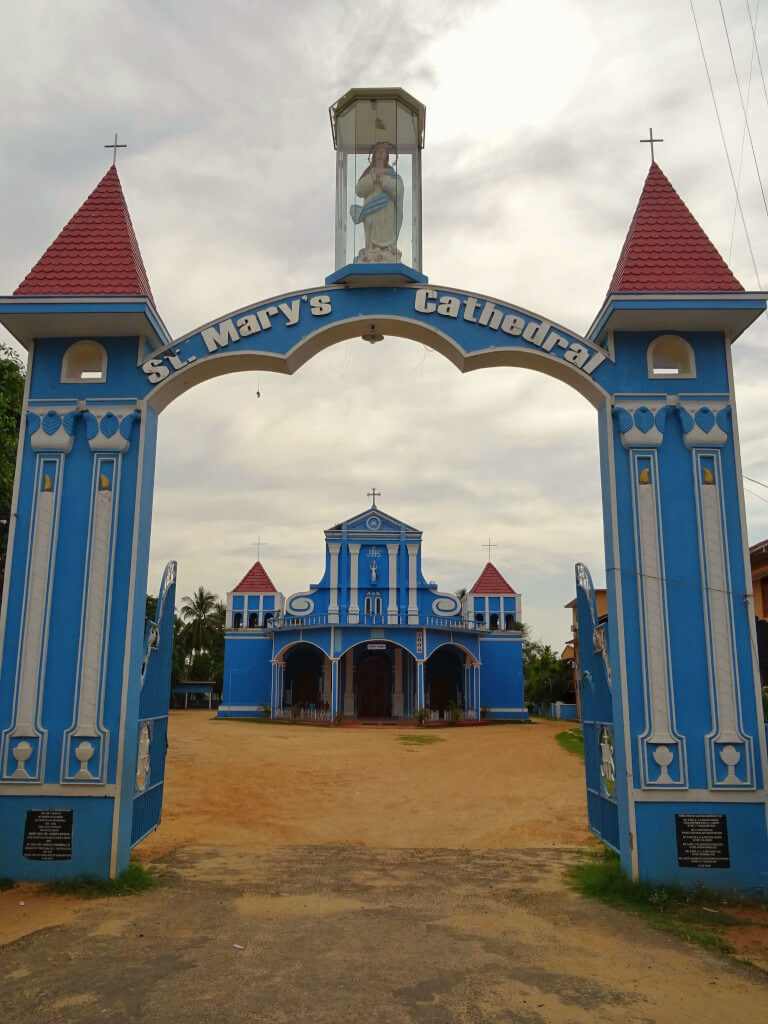
St.Mary’s Cathedral is located in Batticaloa, on the eastern coast of Sri Lanka, the country’s former capital. This eye-catching church, of the Roman Catholic Diocese of Batticoloa in Puliyanthivu, was originally built in 1801 by paschal Mudaliyar. Following a conflict between local Tamil and Muslim groups in the region, the church underwent some damage so was rebuilt in 1994.
Since then the church has stood out with its bright turquoise exterior and grand archway framing the structure from the street. Amid the commercial city, the church has a notably more historical look nestled amongst the bustling streets. With Botticaloa being on the East coast the locals are largely Hindu or Christian, with some Buddhist and Muslim residents so this Church is one of many religious structures to explore in the city. St.Mary’s Cathedral is open to the public and you can go inside to observe the architecture or join in with the local service.
The whole region is well connected with public transport from buses to trains and with the stunning Sri Lankan coastline a stone’s throw away, it’s somewhere you should add to your bucket list.
22. Marthoma Church in Azhikode, Kerala, India
By Athul & Neethu from Our Backpack Tales
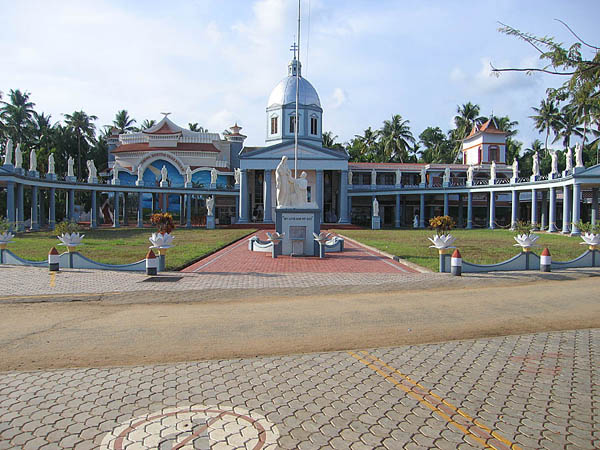
Pic by Sujithvv from Wiki commons CC by SA 3.0
Marthoma Pontifical Church is located in Azhikode, Kodungallur, Kerala. Legend has it that St. Thomas arrived in Kodungallur on November 1st 52.A.D and built the church which is the first of seven. The church is located on the banks of the Periyar river. It is believed that St. Thomas is the first one to have spread the Christian faith on the Eastern coast of India, while St Bartholomew took on the Western coast of India.
The church is now maintained under the Muziris project and is one of the main spots of pilgrimage in Kerala. This ancient church also houses a piece of bone from the right hand of St. Thomas which was brought from Italy.
The church is now a famous tourist spot for tourists visiting Kerala. The church is covered along with other sites under the Muziris project like Palliyam Palace, Jewish Synagogue and Kottapuram Fort. The famous Athirapally falls, Cherai Beach and Azhikode beach are some important tourist places nearby.
If you know of a must-visit Asian church that is not on this list, email me at abby@abbyshearth.com with a pic of it along with a brief history, and we might just add it in.
Other Posts to Read
- Australian Churches to Visit
- Kaka Baptista Museum
- Life in the East Indian village of Poinsur
- Should Christians buy gold?
- African Churches to add to your bucket list
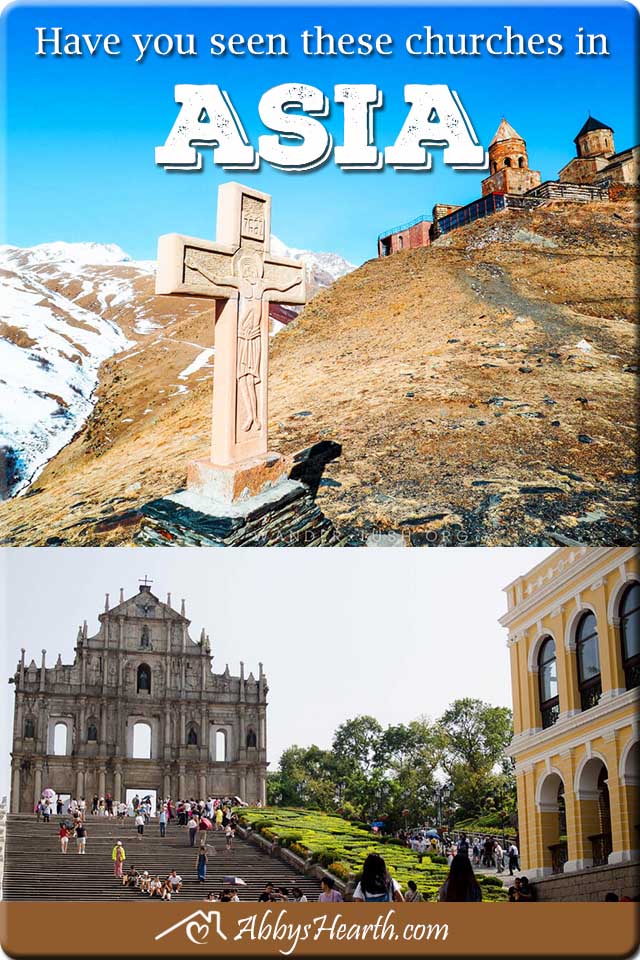
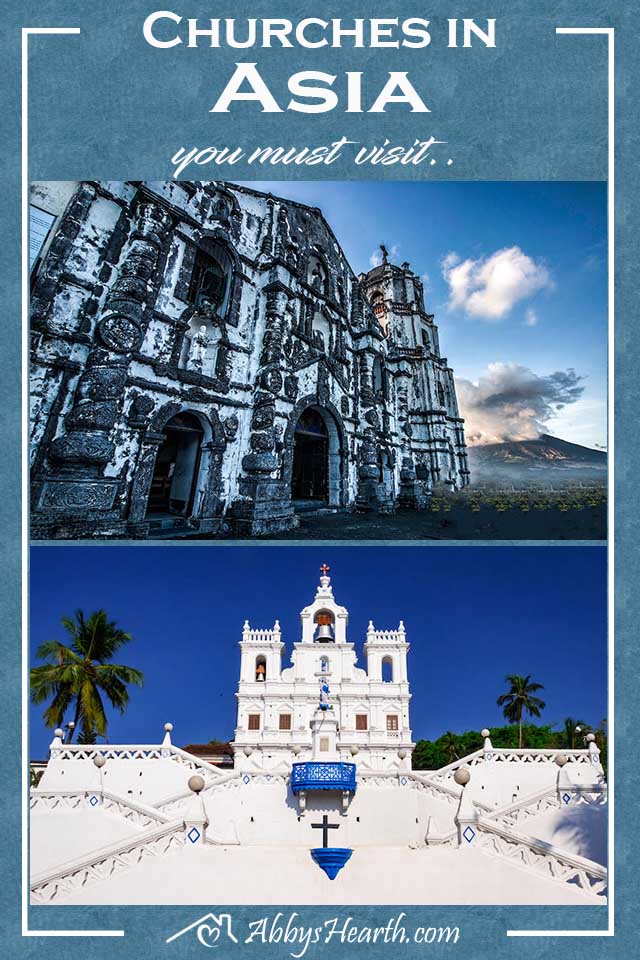
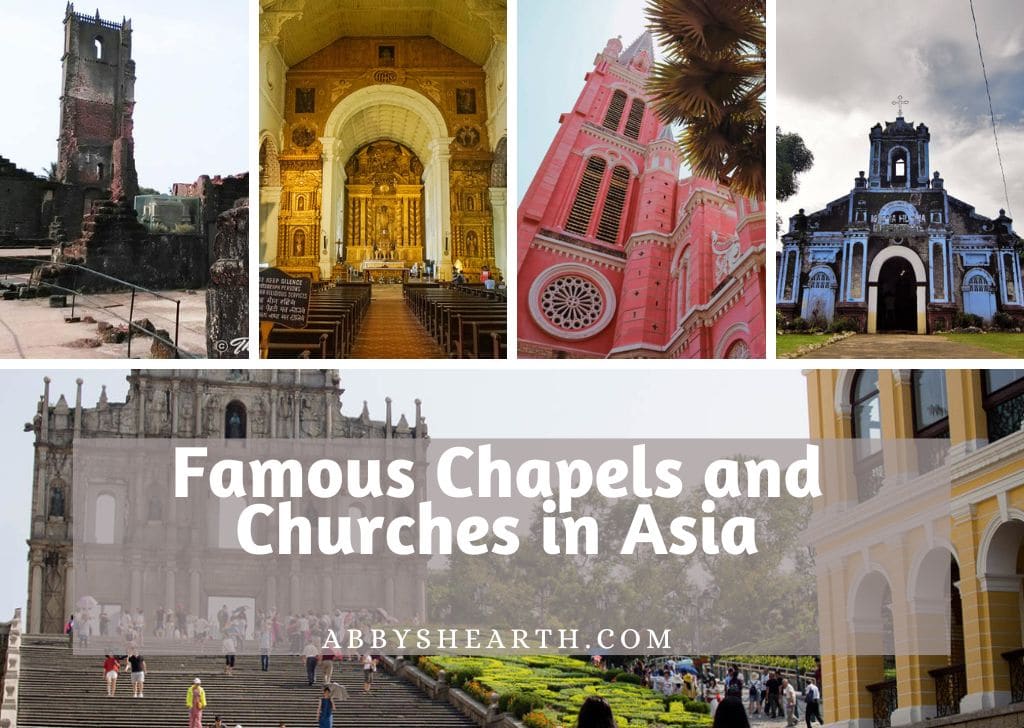



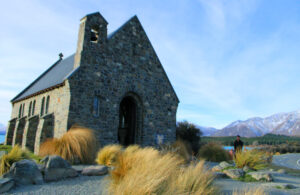

Thats a fantastic list. I have visited seven of them.
Look forward to seeing more added.
Hi. Which 7 did you visited?